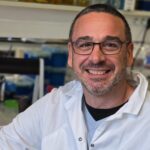Link to Pubmed [PMID] – 27152358
Link to DOI – 10.1126/sciadv.1501914
Sci Adv 2016 Apr; 2(4): e1501914
Bacteria with multiple chromosomes represent up to 10% of all bacterial species. Unlike eukaryotes, these bacteria use chromosome-specific initiators for their replication. In all cases investigated, the machineries for secondary chromosome replication initiation are of plasmid origin. One of the important differences between plasmids and chromosomes is that the latter replicate during a defined period of the cell cycle, ensuring a single round of replication per cell. Vibrio cholerae carries two circular chromosomes, Chr1 and Chr2, which are replicated in a well-orchestrated manner with the cell cycle and coordinated in such a way that replication termination occurs at the same time. However, the mechanism coordinating this synchrony remains speculative. We investigated this mechanism and revealed that initiation of Chr2 replication is triggered by the replication of a 150-bp locus positioned on Chr1, called crtS. This crtS replication-mediated Chr2 replication initiation mechanism explains how the two chromosomes communicate to coordinate their replication. Our study reveals a new checkpoint control mechanism in bacteria, and highlights possible functional interactions mediated by contacts between two chromosomes, an unprecedented observation in bacteria.








